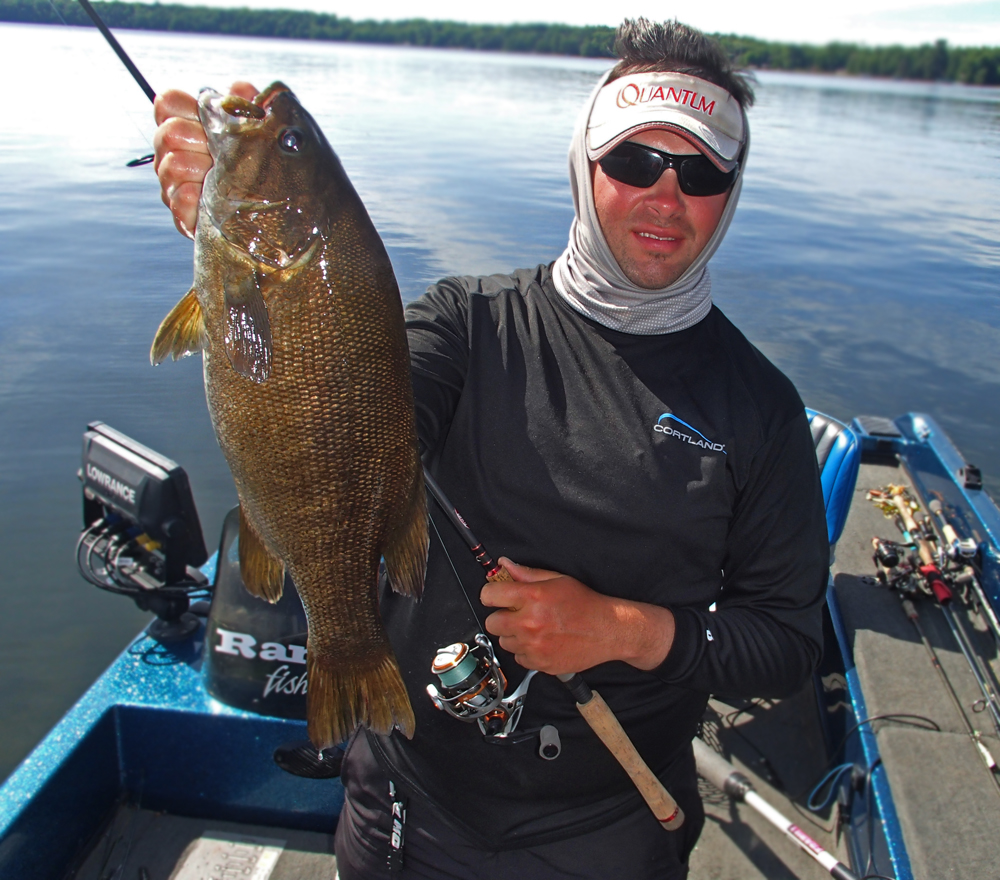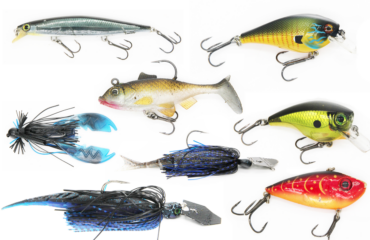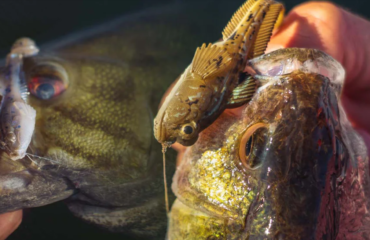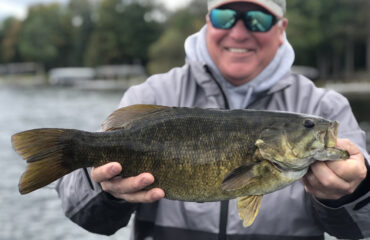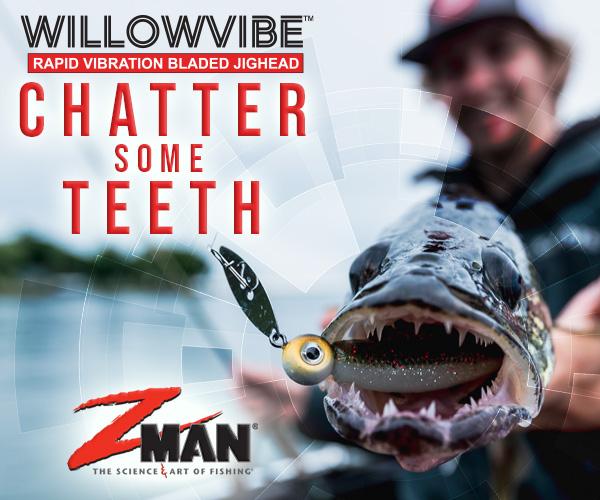Mayfly Magic Smallmouth
Every year, our northern lakes swarm with mayflies. The hatch is considered a negative and detriment to summertime bass fishermen who fail to produce good results. While the lake’s entire food chain becomes temporarily imbalanced from this natural forage abundance, and fixated on it, the prevalence of mayflies rising from the lake’s surface leads to one of the briefest, but engaging and entertaining smallmouth bass fishing patterns and peak periods of the summer fishing season.
Previously my summertime bass fishing strategy was to completely avoid being on lakes that were hatching mayflies. During the hatch, most gamefish will feed heavily on emerging larvae and adult mayflies to the point of over-eating and be disengaged towards everything else. But an eye-opening experience on a guide trip a few seasons ago changed my outlook and perspective on how to deal with this phenomenon. The presence of mayflies rising from the water’s surface, and sight of smallmouth wolfpacks feeding sub-surface, is advantageous and can lead to the best fishing of summer. The catching and easy fishing that ensued has become a summertime scenario I look forward to annually.
Cycle and Hatch
The lifecycle of a mayfly is complex. They live in annual life cycles of which they will be in larval and nymph stage for majority of life. There are many types of mayflies that make up different populations with their own separate life cycles in any one lake, reservoir, river or stream. There can also be different populations of the same mayfly living within the same water which may be on different life cycle schedules, and therefore hatches can take place different times throughout summer.
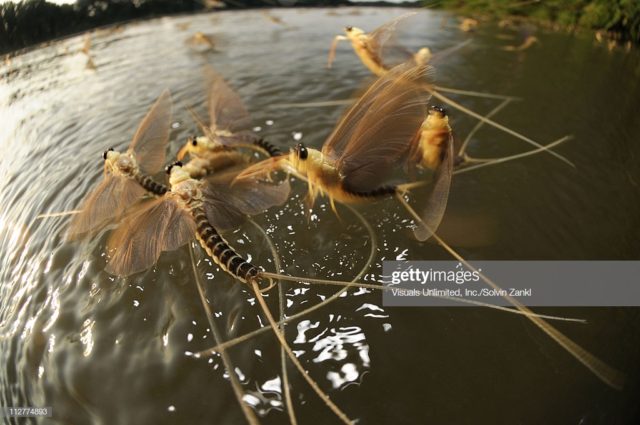
During hatch, mayflies swarm above water’s surface, flying in every which way. They have approximately 24 hours of time to mate with each other and drop eggs back into the water before they die. The eggs will settle to the bottom and incubate from a few days to a few months depending on water temperature and a multitude of other conditions. Once the new larvae hatches, nymphs will live near the lake bottom, under rocks or within decaying vegetation and detritus along the bottom. This nymph stage lasts for several months to almost a full year. Before the nymph molts and becomes an adult fly, it swims to the surface where it rests and emerges from the shell, flying out from water. These fly shells are collected by the wind and then accumulate by the thousands and millions, fouling the water’s surface. This is when fish feeding frenzies begin, as schools of smallmouth feed on the nymphs as they reach the surface and struggle to fly away.
The hatch usually takes place in my northern regions of Wisconsin anytime from mid-June through mid-July. Not every lake experiences mayfly hatches at the same time. The timing of the event, in combination of size and success of mayfly hatches usually depends on climate and overwintering & survival conditions for larvae. Hatches are more drastic and large-scale during summers following warmer winter and spring climates. Meanwhile, hatches are more minimal, spread out, and not as severe following colder, brutal winters and late ice-outs – what we had experienced in 2018.
After summer climate officially settles in and water temperatures reach 70-72 degrees, the larvae awaken to complete their reproductive mission in life. Calm, humid and windless days catalyze and help accelerate the event. These weather conditions are the necessary ingredients to best fishing and patterning the strategy.
Bass Behavior
The hatch coincides with the conclusion of the post-spawn phase, when smallmouth are recovering from spawn, aggressively feeding, and rebuilding their energy stocks for the remainder of the open water season.
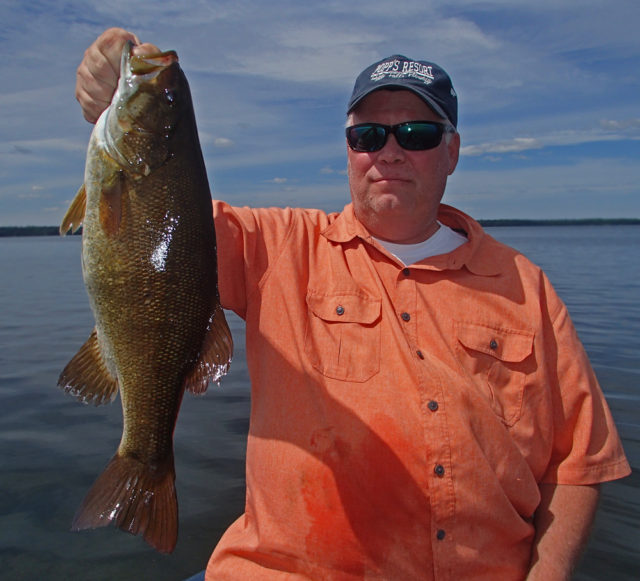
Guide customer and new hair jig angler, Jim Prosser, with a few quality bronzebacks caught with the hait jig technique during a mayfly hatch.
Mayfly hatches occur on all lakes, but waters with moderate to clear transparency offer the best visual experiences and fishing for smallmouth during this window. Good water clarity, coupled with sunny and calm, humid conditions enhances the opportunities to find flies emerging from their most concentrated regions of the lake and observing feeding frenzies of smallmouth in vast areas across the lake’s surface. The surface boils from the mouths and tails of smallmouth slurping adult mayflies that struggle to dry their wings before they can fly away.
The mayfly hatch won’t only be visual above surface, but on your electronics as well. When screens appear cloudy with lines and blotches, Chirp sonar and side-imaging will confirm the presence of mayflies rising upward in the water column. The nymphs below will reach the surface to hatch at any time. Drop a few waypoints and come back to the area when nymphs rise from the water to see whether smallmouth have found these mayfly hatching locations also.
Heavy swarms of mayflies are indicative of a healthy water body and surrounding watershed. Some of the best smallmouth lakes to experience good fishing during the mayfly hatch are clear bodies of water with deep structure, and clean bottom that is mostly comprised of sand and some variation of harder bottom. Clear water with clean bottom drastically improves the visual fishing experience and makes it easy for surface feeding smallmouth to find your baits.
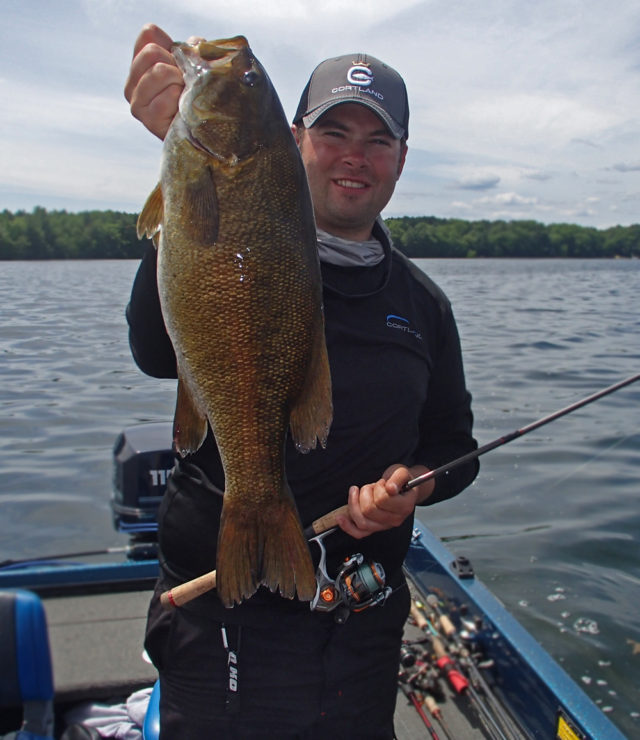
Mayfly hatches occur on all lakes, but waters with moderate to clear transparency offer the best visual experiences and fishing for smallmouth during this window. Good water clarity, coupled with sunny and calm, humid conditions enhances the opportunities to find flies emerging from their most concentrated regions of the lake and observing feeding frenzies of smallmouth in vast areas across the lake’s surface.
When smallmouth are in their feeding frenzy, most catchable and aggressive fish will be in the upper water column, near surface. Some smallmouth wolfpacks can be feeding heavily along shallower flats with a predominant sand and rock/boulder bottom in 5 to 15 ft depths. Meanwhile other smallmouth wolfpacks, such as the lake’s suspending population, can be feeding over the lake’s main basin where they roam freely and unpressured in open water throughout much of the year.
A smallmouth wolfpack’s location depends on where the nymphs are emerging from, as they usually swim straight upward to the surface when they do. Nymph habitat varies on each lake, so it’s necessary to rely on visual cues as to where feeding frenzies are taking place and where you should fish during the hatch. Once visually confirmed, these areas will remain consistent mayfly locations and high producing smallmouth locations for years to come.
The lack of fishing success during mayfly hatches is experienced by anglers who are fishing the wrong areas of the lake with the wrong strategies. During the hatch, majority of the lake’s smallmouth will be relating to, and feeding, where the mayflies are at. Since mayflies aren’t precise structure and habitat oriented like smallmouth are, finding the hatch areas can understandably be difficult because they can take place in no-man’s land. But the areas with fish surfacing will be obvious. Ignoring nature’s cues will lead to continued fishing struggles, while paying attention to surroundings and nature’s response will lead to success.
Hairy Fishing Tactics
During the hatch, some of the best smallmouth fishing of summer can be had by utilizing tactics and strategies that correspond to food chain shifts. When the timing is right, this will allow you to tap into the food chain.
When a wolfpack of feeding smallmouth is found, a handful of presentations are effective if they can be fished on the surface and in the upper water column. Most bass anglers frequently use baits to represent smaller baitfish that can be feeding in these same areas also, but not my boat. Smallmouth schools are in these hatch areas to solely stuff their stomachs full of mayflies.
The best representation of a mayfly is the simple and deadly hair jig.
I’d rather fish with other tactics, but what’s an angler to do when combating mayfly hatches, bug hatches, high skies and no wind, surfacing fish that won’t touch a topwater, and excessive angling pressure? The hair jig out fishes anything else by a wide margin and does so effectively in these adverse conditions.
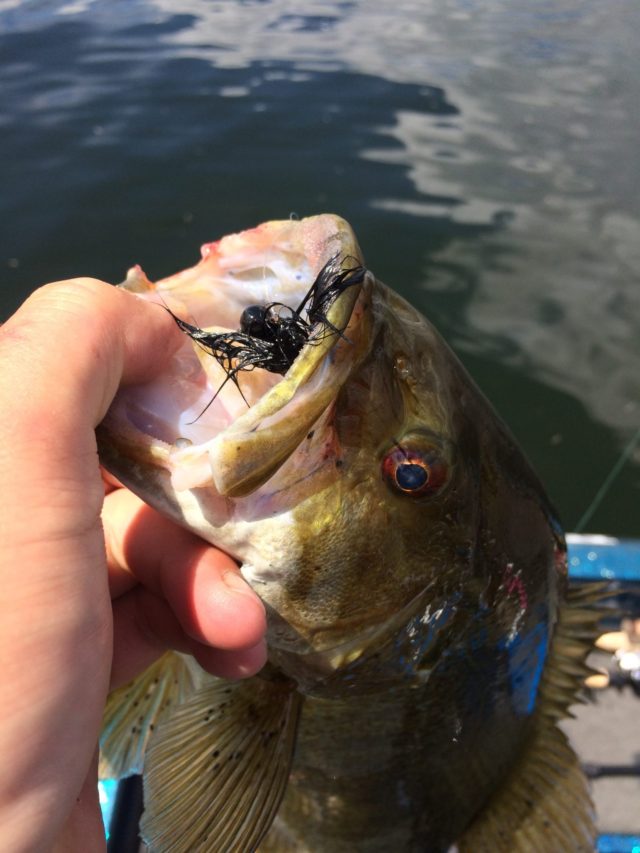
the hair jig is nothing new to fishing, but it remains an unknown to today’s generation of smallmouth, and a little lifelike snack fish won’t grow condition to. The ultra-light weight and extreme slow fall of the hair jig enables it to hang in range of a smallmouth’s strike zone in the upper water column. Let the hair do all the work and slow glide for you.
A few seasons ago, a guide customer and I dealt with a mayfly hatch taking place in the windless, calm regions of the lake we were fishing. What we then observed from a great distance away was a large wolfpack of big smallmouth surfacing, feeding on the flies. If we hadn’t paid attention to our surroundings or had a set of binoculars in the boat, we wouldn’t have been able to find the backs and tails of big surfacing smallmouth, and we would have regrettably left the lake. An estimated 20 to 30 fish were in this school, all at lengths of 18″ or better. The topwater I was throwing wasn’t cutting it, and neither was any other jig. It then registered to me I should tie on a hair jig for some humor and experimentation.
First cast with a 1/16 oz. maribou jig on my 7 ft. medium light action rod, an 18 incher slurped and exploded on it. We were in disbelief, then guide customer and I proceeded to catch a dozen more smallmouth that otherwise were unwilling biters on everything else.
Despite being popular to bass fishing during its advent in the 1950’s and 60’s, the hair jig is nothing new to fishing, but it remains an unknown to today’s generation of smallmouth, and a little lifelike snack fish won’t grow condition to. The ultra-light weight and extreme slow fall of the hair jig enables it to hang in range of a smallmouth’s strike zone in the upper water column. Let the hair do all the work and slow glide for you.
Many of the best quality hair jigs are hand-crafted by avid fly fishermen, anglers, and independent manufacturers. The best hair jigs I’ve used to date are hand tied by Gregg Kizewski, formerly of Super-K Jigs. Most commonly fished for this technique are his 3/32 oz. 1/16 oz. and 1/8 oz. sizes, available in blacks, brown/olives, and purple/chartreuse colors. The Super-K hair jigs are overdressed with pulsating marabou, benefitting the slow glide and hangtime. If the jig doesn’t meet personal preferences, snip and remove excess hair to downsize the jig, and increase the fall rate.
Wind, depth, line weight, and how fast you plan to work hair jigs should all be considered when choosing the correct hair jig that will present best. With medium light to medium extra fast action spinning tackle, rod lengths of 6 and a half to 8-foot lengths, I fish the lightest and longest Quantum PT rod and reel setup that I can get away with, on light 10 lb. Cortland Masterbraid, tied to a 5 ft. section of 6 and 8 lb. Cortland Line or Seaguar fluorocarbon leader. For attaining slower fall, consider increasing braided main-line size to 15 lb. The slow fall of these baits enables you to fish the bait horizontally through the water column at a very slow pace. Cast out as far as you can reach, let the jig glide down to the desired depth, point the rod tip down, and start reeling. Let the hair pulsate and do all the work. Lift and drop your rod throughout the retrieve with a rip jigging method to trigger strikes and help maintain sub-surface depth.
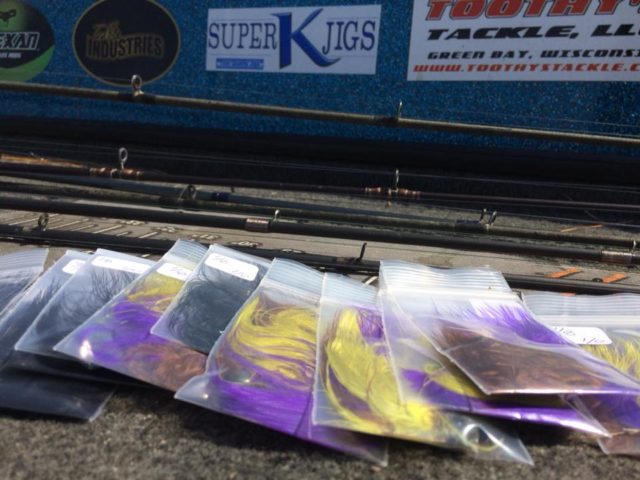
The Gregg Kizewski’s hair jigs are overdressed with pulsating marabou, benefiting the slow glide and hang time. If the jig doesn’t meet personal preferences, snip and remove excess hair to downsize the jig, and increase the fall rate.
While hair jigs are the primary tools and will catch most fish, a secondary presentation is worthy of consideration, especially if fish are slurping flies with more aggression. Topwaters fished on casting gear such as Rapala X-Rap Pops, and downsized prop-baits like Heddon’s Tiny Torpedo fished on spinning tackle will pique surface-feeding smallmouth interest. Topwaters are an advantage during the hatch, enabling you to fish quickly in an attempt of covering water. This is significant if the lake is of very large acreage and there are several different hatch zones where smallmouth can be present near.
If neither hair jig or topwater seals the deal, small black Ned Rigs with light heads have a slow hang time and rate of fall, behaving similarly to hair jigs. If minnows and baitfish are present with smallmouth in feeding areas, adapt by fishing translucent minnow imitating swimming plastics such as a 3 or 5-inch Kalin’s Lunker Grub, rigged weightless and fished with straight retrieve.
If your lake is hatching mayflies, locating smallmouth and catching them is easier than imagined.
Ultimately what lures or baits are chosen and how they are fished is not nearly as important as being in the right place at the right time and making sure presentations stay in the upper water column and can hang in a smallmouth’s strike zones the longest. Don’t let a mid-summer mayfly hatch ruin an outing or even an entire week’s worth of fishing. The most successful smallmouth fishermen are those who are willing to adapt to any given set of circumstances and take advantage of a seasonal peak feeding period.
Every smallmouth angler must try to understand the complexities of insect hatches and the temporary changes and fishing advantages they create in aquatic food chains and smallmouth bass predator-prey relationships. This knowledge will help better understand and implement successful fishing strategies that capitalize on the feeding behaviors of big smallmouth bass during these times.
Andrew Ragas splits time between the Chicago area and Wisconsin’s Northwoods. Based in Minocqua, WI, he specializes in trophy bass fishing and offers guided trips from May thru October. While big bass is the passion, he dabbles in multi-species as well. He may be visited online at www.northwoodsbass.com


